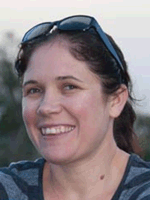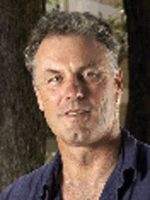Monitoring demersal scalefish populations in the Browse Basin region: accounting for spatial variability and detecting change in key fish populations
Russ Babcock A D , Emma Lawrence A , Tonya van der Velde A , C. Roland Pitcher A , Mark Tonks A , Cindy Bessey A , Euan Harvey B and Stephen J. Newman B CA CSIRO Oceans and Atmosphere, GPO Box 2583, Brisbane, Qld 4001, Australia.
B Department of Environment and Agriculture, Curtin University, PO Box U1987, Perth, WA 6845, Australia.
C Western Australian Fisheries and Marine Research Laboratories, Department of Fisheries, Government of Western Australia, PO Box 20, North Beach, WA 6920, Australia.
D Corresponding author. Email: russ.babcock@csiro.au
The APPEA Journal 57(2) 382-387 https://doi.org/10.1071/AJ16251
Accepted: 21 March 2017 Published: 29 May 2017
Abstract
One of the objectives of the Applied Research Program (ARP), funded by Shell and the INPEX-operated Ichthys LNG Project, was to establish the basis for evaluating the effects of any potential oil spill from the Prelude or Ichthys fields on populations of commercially important demersal fishes in the Northern Demersal Scalefish Managed Fishery. The ARP has delivered improved baseline understanding of the status and spatial variability in populations of commercially and ecologically important finfish of the Browse Basin region, in the vicinity of the Prelude and Ichthys fields, using both commercial-style fish traps and baited remote underwater videos (BRUVs) as sampling methods. We used available environmental-data layers and fish-distribution data, in combination with modelled plume projections, to design a study such that sites were balanced with respect to fish habitat and likely affected and unaffected zones. The sampling-design employed was statistically effective with power to show changes in fish assemblages, and relative abundance of as little as 30% could be detected with 80% certainty in the main commercial species, goldband snapper (Pristipomoides multidens), using BRUVs. For the second-most important species, red emperor (Lutjanus sebae), a larger decline of 50% would have to occur for this change to be determined with the same level of confidence. Traps were a more powerful tool for sampling L. sebae, allowing a 40% change to be detected; however, for all other species BRUVs were more powerful. Sampling of the demersal-fish assemblages surrounding the Prelude and Ichthys fields by using both fish traps and BRUVs demonstrated the feasibility of detecting change in the relative abundance of the fish assemblage as well as in the key commercial species.
Keywords: baited remote underwater video, BRUV, deepwater, effect size, fishery, hydrocarbon, hydrocarbons, sampling design, statistical power, trap.

Dr Russ Babcock is a Senior Principal Research Scientist with CSIRO Oceans and Atmosphere and leads research exploring the natural and human forces that shape our amazing coastal ecosystems and sustain their integrity and value. He has broad interests including invertebrate reproduction and larval ecology, the effects of coastal development, marine conservation and trophic cascade effects to better understand how human activities influence coastal ecosystems, such as coral reefs and kelp forests These research programs focus on issues such as effectiveness of marine reserves as conservation tools and their use as tools for understanding the effects of fishing and fisheries management in coral reef and temperate kelp forest ecosystems. Russ is also active in research into the impacts of phenomena such as sedimentation on coastal, coral reef and seagrass Ecosystems, particularly including the application of new technologies such as Autonomous Underwater Vehicles and acoustic tagging and tracking to provide new ecological insights for better management. |

Emma Lawrence is a senior statistician working in the Data 61 group in CSIRO. Emma has had a focus on statistical issues in marine monitoring and fisheries management for more than ten years. Much of her current research is focused on the design and analysis of monitoring programs for marine conservation and areas that may be affected by environmental pressures. |

Tonya van der Velde has participated in a diverse variety of themes and roles since commencing with CSIRO Marine and Atmospheric Research since 1983. She is a specialist in reproductive biology with international standing. Her science field and expertise has supported research in understanding reproductive biology of penaeid prawns and pelagic fish species and has been pivotal in contributing to stock assessment to various fisheries. Tonya also leads the logistics and co-ordination of field research on a variety of teams on important coastal marine and economic issues. She is highly adaptable and consistently delivers projects whilst developing critical relationships with external clients and agencies. She is also a highly skilled Histologist and is the manager of the Oceans and Atmospheric Flagship histology department. More recently Tonya has been a pivotal member of the Marine Debris Team and has assisted the Project leaders to conduct coastal marine debris field surveys, engaging with schools and interest groups through the TeachWild program. Her consistent work has resulted in a highly commended research award and numerous performance recognition awards. |

Dr C. Roland Pitcher provides a science foundation supporting management for sustainability of the seabed environment. He has more than 30 years’ experience in marine ecology and fisheries research, covering coral reef fishes, tropical rock lobster, effects of trawling, recovery & dynamics, biodiversity mapping & prediction, modelling & assessment, and management evaluation. |

Mark Tonks is an Experimental Scientist with CSIRO’s Oceans and Atmosphere Business Unit at the Ecosciences Precinct, Dutton Park, Brisbane, Queensland. Mark completed an Environmental Science Degree at Griffith University in 1991 and then went on to complete a Post-Graduate Diploma in Marine Science at the University of Queensland in 1994. Mark has worked for CSIRO for over 15 years and his research interests lie in fish, crustacean and plankton taxonomy, trawl bycatch sustainability and monitoring commercially exploited prawn and lobster populations in northern Australia. Mark has lead several large field surveys, co-ordinates shipping logistics for the Integrated Marine Observing System (IMOS) Australian Continuous Plankton Recorder Survey, has completed over 300 commercial research dives for CSIRO, holds an unrestricted Coxswains licence and is currently the CSIRO Boat Officer for Brisbane. |

Cindy Bessey is a marine ecologist whose passion is understanding the role of lower trophic fauna in sustaining diverse, productive and healthy ecosystems. Cindy’s research has included investigating trophic interactions in threatened seagrass ecosystems, evaluating how commercially important fish populations are affected by varying environmental conditions, and assessing the risk that genetically modified fish pose to the natural environment. Her current work focusses on obtaining baseline data in coastal and offshore systems in order to evaluate risks from both anthropogenic and natural pressures. Cindy is a first responder for CSIRO’s marine incident response team providing scientific knowledge and technical support to industry in the event of an oil spill. Her international employment experience includes positions with the Western Australian Department of Parks and Wildlife, the National Oceanic and Atmospheric Administration in California, USA, and the Department of Fisheries and Oceans in British Columbia, Canada. |

Euan Harvey’s research focuses on marine fishes and how physical (both natural and man-made) structures and oceanographic processes influence their composition and distribution. The effects of anthropogenic activities such as fishing, increases in sedimentation, climate change, increases in marine noise (e.g. seismic surveys) are areas of active research. Over the last 20 years a focus of Euan’s research has been developing, testing and implementing robust fishery independent sampling techniques which use underwater stereo-video technology for sampling the relative abundance and lengths of fish remotely. He has active collaborations with the state and federal agencies both in Australia (e.g. Department of Fisheries in Western Australia, The Department of Parks and Wildlife WA, Parks NSW, CSIRO Marine, The Australian Institute of Marine Science) and internationally (The National Marine Fisheries Service). |

Stephen J. Newman is a Principal Research Scientist in the Science and Resource Assessment Division of the Department of Fisheries, Government of Western Australia. His research has primarily involved investigating the status and assessment of the fish resources of Western Australia. This includes assessing bycatch and discarding issues, investigating protected species interactions and developing mitigation strategies, evaluation of non-destructive assessment techniques, examining the biology and ecology of fishes with particular relevance to fisheries, effects of climate change on fish and fisheries of tropical WA, and Marine Stewardship Certification (MSC) assessment of relevant fisheries. This research has meant working closely with industry and management, and has been pivotal in shaping the sustainable management of the State’s finfish fisheries resources. |
References
APASA (2013). ‘Brewster Development Wells WA 285: Quantitative Oil Spill Exposure Modelling. J0203 – INPEX WA285 Development – Rev 0.’ (Asia–Pacific Applied Science Associates: Perth, WA.)Brodie, P., Fuller, M., Rees, T., and Wilkes, L. (2006). Data warehouse and metadata holdings relevant to Australia’s North West Shelf. NWSJEMS technical report no. 5. CSIRO Marine and Atmospheric Research, Hobart, Tas. Available at http://www.cmar.csiro.au/nwsjems/reports/NWSJEMS_TR5.pdf [Verified 27 March 2017].
Ellis, N., Smith, S. J., and Pitcher, C. R. (2012). Gradient forests: calculating importance gradients on physical predictors. Ecology 93, 156–168.
| Gradient forests: calculating importance gradients on physical predictors.Crossref | GoogleScholarGoogle Scholar |
Gagnon, M. M., and Rawson, C. (2011). ‘Montara Well Release, Monitoring Study S4A: Assessment of Effects on Timor Sea Fish.’ (Curtin University: Perth, WA.)
Harvey, E. S., Newman, S. J., McLean, D. L., Cappo, M., Meeuwig, J. J., and Skepper, CL (2012). Comparison of the relative efficiencies of stereo-BRUVs and traps for sampling tropical continental shelf demersal fishes. Fisheries Research 125– 126, 108–120.
Koslow, J. A., Last, P., Williams, A., and Sabourenkov, P. (1999). Exchange and analysis of historical Soviet fishery survey data from the waters around Australia. Final report to the Fisheries Research Development Corporation, FRDC Project 93/239.
Newman, S. J., Wakefield, C., Skepper, C., Boddington, D., Blay, N., Jones, R., and Wallis, D. (2014). North Coast Demersal Fisheries status report. In ‘Status Reports of the Fisheries and Aquatic Resources of Western Australia 2013/14: the State of the Fisheries’. (Eds W. J. Fletcher and K. Santoro.) pp. 192–360. (Department of Fisheries, Western Australia: Perth, WA.)
Pitcher, C. R., Ellis, N., and Smith, S. J. (2011). ‘Example Analysis of Biodiversity Survey Data with R Package GradientForest.’ R vignette. Available at http://gradientforest.r-forge.r-project.org/biodiversity-survey.pdf [Verified 27 March 2017].
Pitcher, C. R., Lawton, P., Ellis, N., Smith, S. J., Incze, Ls., Wei, C., Greenlaw, M. E., Wolff, N. H., Sameoto, J. A., and Snelgrove, P. V. R. (2012). Exploring the role of environmental variables in shaping patterns of seabed biodiversity composition in regional-scale ecosystems. Journal of Applied Ecology 49, 670–679.
| Exploring the role of environmental variables in shaping patterns of seabed biodiversity composition in regional-scale ecosystems.Crossref | GoogleScholarGoogle Scholar |
Sainsbury, K. J. (1987) Assessment and management of the demersal fishery on the continental shelf of north-western Australia. In ‘Tropical Snappers and Groupers: Biology and Fisheries Management’. (Eds J. J. Polovina and S. Ralston.) pp. 465–503. (Westview Press: Boulder, CO.)
Stewart-Oaten, A., Murdoch, W. M., and Parker, K. R. (1986). Environmental impact assessment: ‘pseudoreplication’ in time? Ecology 67, 929–940.
Underwood, A. J. (1992). Beyond BACI: the detection of environmental impacts on populations in the real, but variable, world. Journal of Experimental Marine Biology and Ecology 161, 145–178.
Williams, A., Dunstan, P., Althaus, F., Barker, B., McEnnulty, F., Gowlett-Holmes, K., and Keith, G. (2010). Characterising the seabed biodiversity and habitats of the deep continental shelf and upper slope off the Kimberley coast, NW Australia. Final report to Woodside Energy Ltd. CSIRO Wealth from Oceans, Hobart, Tas.


